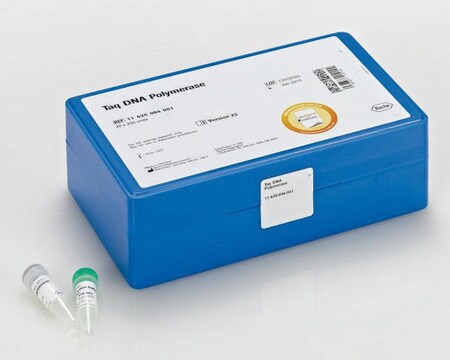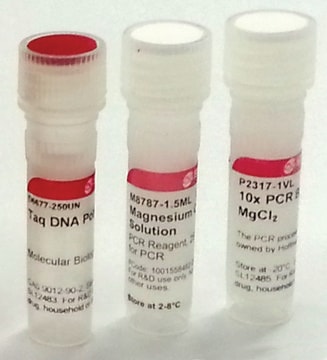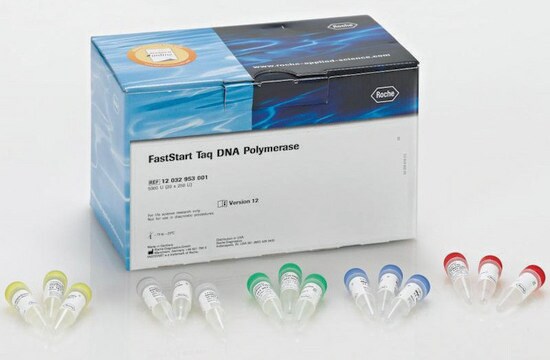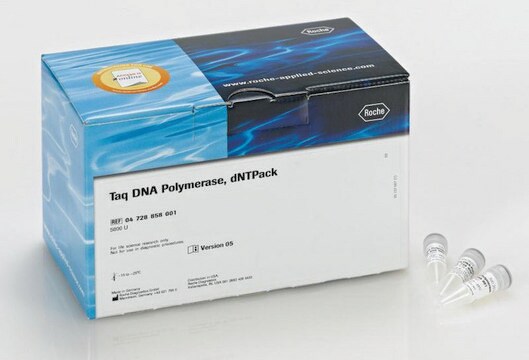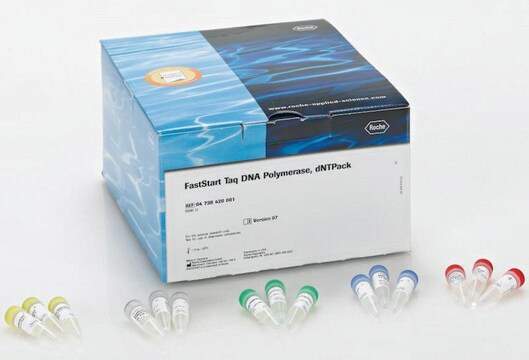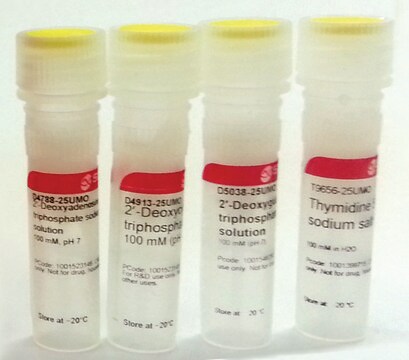Kluczowe dokumenty
TAQL-RO
Roche
Taq DNA Polymerase, 1 U/μl
suitable for PCR, hotstart: no, dNTPs included: no
Synonim(y):
dna amplification, pcr, polymerase, primer extension
About This Item
Polecane produkty
pochodzenie biologiczne
bacterial (Thermus aquaticus BM)
Poziom jakości
rekombinowane
expressed in E. coli
Formularz
liquid
zastosowanie
sufficient for ≤2,000 reactions (11647687001)
sufficient for ≤500 reactions (11647679001)
aktywność właściwa
1 U/μL
masa cząsteczkowa
~95 kDa
Właściwości
dNTPs included: no
hotstart: no
opakowanie
pkg of 1,000 U (11647687001 [4 x 250 U])
pkg of 250 U (11647679001)
producent / nazwa handlowa
Roche
stężenie
25 U/mL
30 U/mL
Parametry
72 °C optimum reaction temp.
metody
PCR: suitable
kolor
colorless
moc wejściowa
purified DNA
optymalne pH
~9.0 (20 °C)
rozpuszczalność
water: miscible
przydatność
suitable for PCR
suitable for molecular biology
numer dostępu NCBI
numer dostępu UniProt
Zastosowanie
genomic analysis
life science and biopharma
obecność zanieczyszczeń
Endonucleases 20 units, none detected
Nicking activity 20 units, none detected
temp. przechowywania
−20°C
Powiązane kategorie
Opis ogólny
The high processivity, absence of exonuclease activity and temperature optima of Taq DNA Polymerase enable the use of this enzyme in DNA sequencing, especially where the resolution of secondary structures plays a major role.
Zastosowanie
- PCR
- RT-PCR
- Other primer-extension reactions, such as sequencing and labeling
Opakowanie
Definicja jednostki
Unit Assay: Incubation buffer:
67 mM Tris/HCl; pH 8.3/25 °C, 5 mM MgCl2, 10 mM Mercaptoethanol, 0.2% Polydocanol, 0.2 mg/ml Gelatine, 0.2 mM each dATP, dGTP, dTTP and 0.1 mM dCTP.
Incubation procedure:
M13mp9ss, M13 primer (17mer) and 1 μCi (α-32P) dCTP are incubated with suitable dilutions of Taq DNA Polymerase in 50 μl incubation buffer at +65 °C for 60 minutes. The amount of incorporated dNTPs is determined by trichloroacetic acid precipitation.
Volume Activity: 1 U/μl
Inne uwagi
Informacje prawne
Tylko elementy zestawu
- Taq DNA Polymerase 1 U/μl
- PCR Buffer with MgCl<sub>2</sub> 10x concentrated
- MgCl<sub>2</sub> Stock Solution
- PCR Buffer without MgCl<sub>2</sub>
Zwroty wskazujące rodzaj zagrożenia
Zwroty wskazujące środki ostrożności
Klasyfikacja zagrożeń
Aquatic Chronic 3
Kod klasy składowania
12 - Non Combustible Liquids
Klasa zagrożenia wodnego (WGK)
WGK 2
Temperatura zapłonu (°F)
does not flash
Temperatura zapłonu (°C)
does not flash
Wybierz jedną z najnowszych wersji:
Masz już ten produkt?
Dokumenty związane z niedawno zakupionymi produktami zostały zamieszczone w Bibliotece dokumentów.
Klienci oglądali również te produkty
Nasz zespół naukowców ma doświadczenie we wszystkich obszarach badań, w tym w naukach przyrodniczych, materiałoznawstwie, syntezie chemicznej, chromatografii, analityce i wielu innych dziedzinach.
Skontaktuj się z zespołem ds. pomocy technicznej